Choose between flowing and storage water heaters
Many users of the central hot water system faced problems with water supply: for technological and hygienic purposes, heating units need to be repaired, modernized drainage systems, and flushed pipelines. Disconnection of hot water may occur due to an emergency. Therefore, the owners of apartments have to worn from time to time with basins. The same fate befalls those who live in their summer cottage or cottage in the summer period. To continuously provide hot water, manufacturers offer a huge range of devices of various types. The most widely known are the flow and storage options of water heaters, and which one is better or more profitable - we find out in this review.
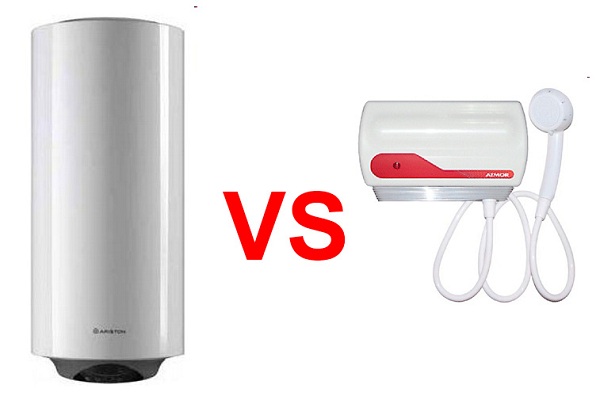
Content
Purpose and main types
So, the domestic water heater is designed to provide hot water to the population if there is no centralized hot water in the house. The main advantages of using such equipment include:
- independence from the CHP operation mode;
- convenient and economical way to quickly get heated water for domestic needs for a long time;
- the ability to service multiple water points;
- the magnitude of the heating fluid is the same;
- a huge selection of shapes that fit into the interior.
Depending on the fuel used in the construction, the devices are divided into 3 types:
- Gas. This type of column is called because of the large capacity with liquid. The system is the most economical to operate, but special conditions are needed for installation (removal of combustion products by means of a chimney, installation space).During the work it is necessary to observe fire safety measures.
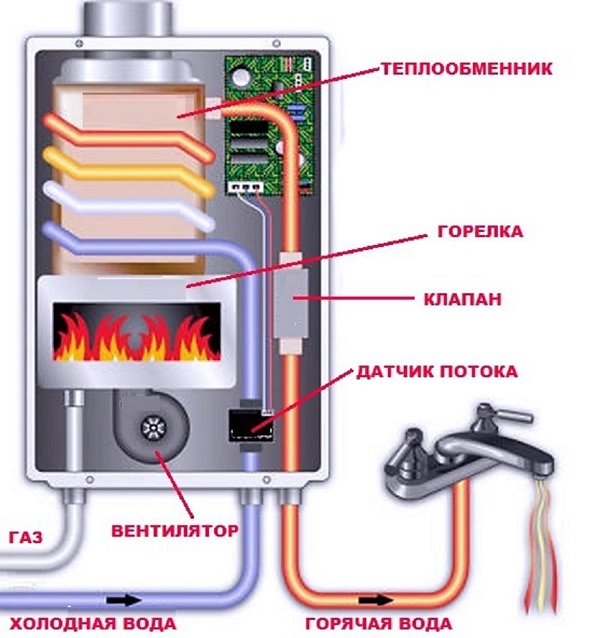
- Electric. The design is characterized by a tubular electric heater. Due to its versatility and a huge range of water-heating equipment of this type is very popular. There are models with remote control.
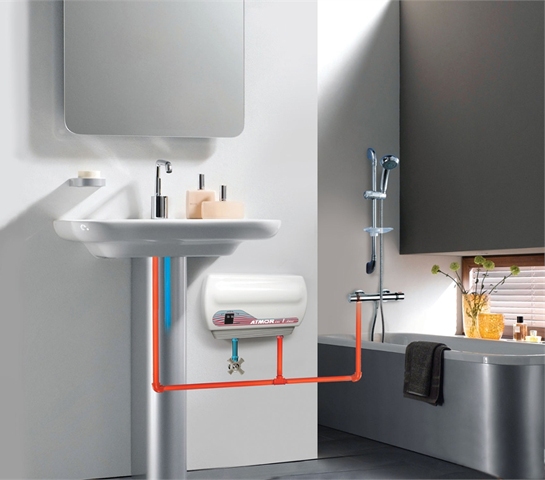
- Indirect. The equipment is connected to the heating boiler. The temperature is maintained for a long time (4-8 hours). Due to the possibility of choosing a design in a complete set with a boiler, an indirect unit reduces the cost of water supply to a minimum.
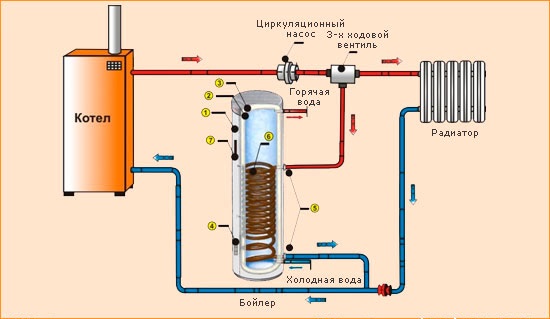
To answer the question, which water heater is better for a city apartment or a private building - flow-through or accumulative, consider the mechanism of operation and the main components of the two devices.
Device and mechanism of operation of flow heaters
This type of water heater is a complex structure. without water tank. The temperature of the liquid increases a few seconds after switching on the equipment. The popular manufacturers of flow type heaters include: “Ariston”, “Electrolux”, Garanterm, Gorenje, Thermex and others.
The device is a small rectangular panel with a tubular electric heater - Heater.
The main components of the device:
- electric heating elements;
- water supply / discharge pipe;
- electronic control unit;
- Remote Control.
Budget models are completed thermostat, with which you can regulate the heating of heating elements. Premium appliances are equipped digital control panel. As a result, management is easier and more visually evident.

Scheme of electric instantaneous water heater
The instantaneous water heater has the following mechanism of operation:
- the special flask contains TEN of high power;
- when starting the water pump, the flowing fluid passes through the heating element;
- if the head power is higher, the water temperature is lower;
- when the valve is closed, the device automatically shuts off.
A warning! Do not use the device without proper grounding.
Depending on the energy source that is used, the flow-through heating equipment is divided into:
- electrical;
- gas.
Acquaintance with the features of each type will help you choose a flow heater.
Powered by electricity
This type of technology is valued for its small size when heating large volumes of fluid. The model is popular for elementary installation. There are 2 ways to control:
- regulation of the increase / decrease of water pressure through the mixer;
- by adjusting the power of the tubular heating element (three-level regulator).
Electric heaters are divided into 2 types according to the principle of operation.
- Pressure head. The instantaneous water heater of this type is an interconnected part of the plumbing system. The pressure in the design is not more than 6 bar. They are installed near the riser and at the required power they heat water at several points in the house. Water heaters are not completed with additional equipment (nozzles or mixers). The device is mounted under the sink. The advantages include an electronic control system: after heating, the temperature of the liquid is kept at a certain level. The disadvantages are significant cost and energy costs.
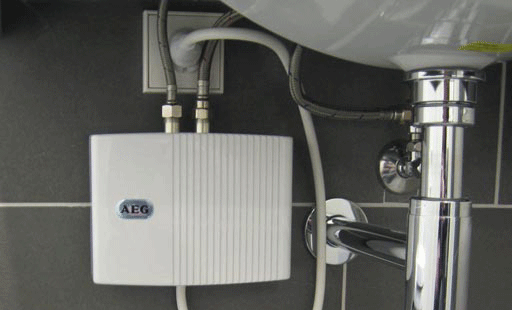
Electric flow pressure water heater
- Non-pressure. Devices of this type are installed autonomously at some elevation. Cold water is supplied manually or by a pump.The process of water intake is carried out under pressure and is located at one point. The kit includes a mixer or nozzle, with their help, the liquid overlaps at the entrance. The advantages include easy installation, simple replacement of the heating element. In addition, the device can operate in the absence of electricity, central water supply. This modification is most often installed in city apartments.
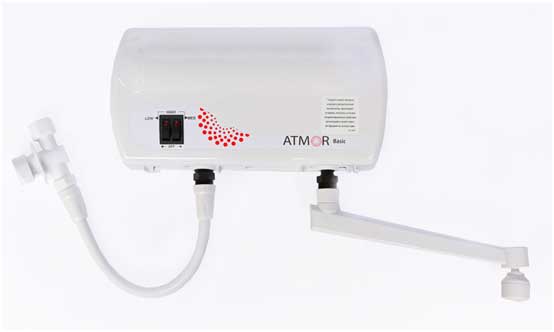
Electric flow-free non-pressure water heater
Note! Electric pressure water heaters of the flow-through type heat water in several water points, and pressureless water heaters - only one. In this case, for equipment with a power of more than 3 kW, they use not a usual network, but a three-phase system.
Gas powered
This kind of technology uses household gas as an energy source. As a result of combustion, a large amount of heat is released to heat the liquid. The device has a burner that maintains high temperature at the outlet. With electric ignition, the gas heater starts in automatic mode - just open the hot water faucet.
Power devices can be small (from 17 to 19 kW), medium (from 22 to 24 kW), maximum (from 28 to 30 kW). Gas flow heaters are more economical than electric ones. If water is necessary for a shower, the water heater should be chosen of medium and low power. To use in the kitchen and bathroom, use gas appliances with a capacity of more than 24 kW.
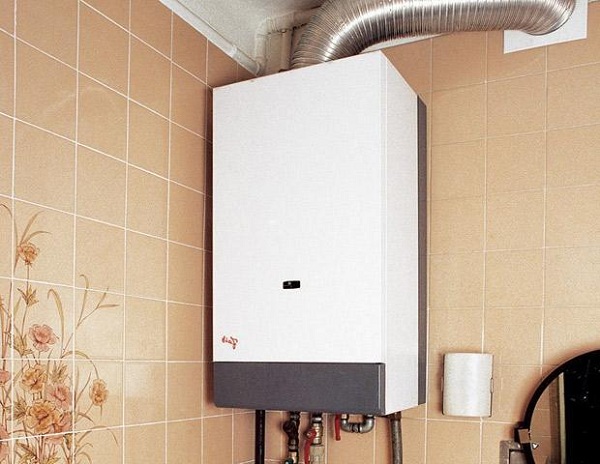
The device and mechanism of operation of storage water heaters
The boiler is the most popular heating technology. The system consists of a heat-insulated reservoir with a heat source, which is installed inside or under the structure. Because of the low power, the design is suitable for country houses and apartments with insufficiently powerful electrical wiring.
The main components of the device:
- housing;
- heat insulation;
- electric heating elements;
- cold water supply pipe;
- flow breaker;
- electronic control unit or thermostat;
- temperature regulator;
- hot water outlet pipe;
- control panel (depending on configuration).
The unit has Control block. Thanks to it, the heating temperature is set. The fluid reservoir is calculated based onhow many people will use it and how often. The lower threshold for one family member is 50-80 liters.
As in the case of flow, there are electric and gas water heaters accumulative type. Many manufacturers are represented on the sanitary market, so it is sometimes difficult to deal with the presented assortment. To figure out which boiler is suitable for a dacha or a city apartment - gas or electric, and what are their differences, consider next.
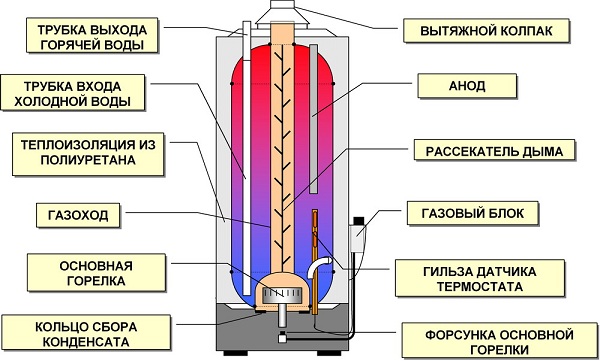
Gas water heater
Electric storage heaters are versatile due to low power (from 1 kW to 6 kW). To connect you do not need a special power cable. Gas units of a similar level have a capacity of 4-6 kW. For comparison: to heat 150 liters of water, the gas device takes 1 hour, the electric water heater takes 2-3 hours.
Note! Prices for gas boilers and the cost of their installation is higher than for electrical devices. But the cost of domestic gas is less than electricity.
Advantages and disadvantages of both types of water heaters
Which is preferable - instantaneous or storage water heater? For the answer, consider the pros and cons of the twovarieties of technology.
| Water heaters | Merits | disadvantages |
| Electric flow | compactness;
high efficiency; uninterrupted supply of hot water
|
high power consumption;
special requirements for power grids |
| Gas flow | compactness;
reliability; high power; low costs for natural gas; can be used for space heating
|
good water pressure is needed;
combustion products are emitted, therefore the chimney is obligatory; mandatory compliance with fire safety regulations |
| Electric storage | unlimited number of water points;
low power |
large dimensions;
significant time spent on heating fluid |
| Gas storage | the number of collapsible points - more than 1;
low power for heating large volumes of water; economical |
significant size;
high price |
Analysis of the main pros and cons of the two types of water heaters showed that all devices have both positive characteristics and negative ones.
Comparison of devices on the main characteristics
To analyze in detail the technique of the main parameters, we reduce the characteristics in the table:
| Indicator | Flow through | Accumulative |
| Maximum temperature | +500WITH | +850WITH |
| Dimensions | Low weight and size | Large weight (up to 60 kg) |
| Water flow | Significant | Acceptable |
| power usage | The voltage level must be constant, a separate power cable is required for heating elements up to 27 kW. Energy consumption occurs at the moment of intake | Small power: 3-7 kW |
| Installation | Easy mount.
For devices with a capacity of more than 9 kW, separate wiring is required - a three-phase network of 380 V |
Wall mounted devices are mounted on a supporting base with brackets. No additional connection requirements |
| Heating element care | 1 time in several years to clean the heater | Regular cleaning, replacement of the magnesium anode at least once in 6-12 months |
| Security | for gas - additionally you need a chimney and ventilation system;
for electrical - to comply with safety measures during operation |
RCD and grounding |
| Type of heating room | Country house, summer house, city apartment | Apartment, private household |
| Life time | Up to 5 years | Up to 10 years |
| Cost, rub | Over 800 | From 3000 |
Popular models of famous manufacturers
European brands Ariston, Electrolux, Indesit, Bosch,Valliant is the most reliable product according to customer reviews. The devices are adapted to the Russian parameters of water composition, pressure and other criteria. Working elements are made of stainless steel or nickel-plated steel and are equipped with high-quality parts that protected by anti-corrosion coating. Heaters are made with increased requirements for fire safety and serve more than 10 years. Consider the most popular models.
Flowing water heaters
- Electrolux GWH 265 ERN Nano Plus. Device attributed to gas mechanically controlled units. Additional features include overheating protection with a safety valve. The device can operate with reduced gas pressure. Rated power of the device is 20 kW. Appliances are mounted on the wall. On the panel is a digital display, which makes the management convenient and functional. The cost of 6000 rubles.
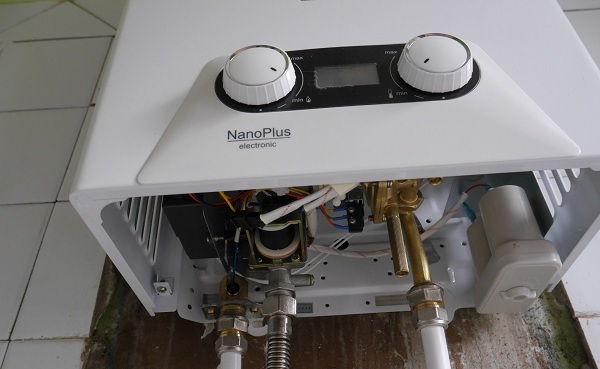
Gas Electrolux GWH 265 ERN Nano Plus heater
- VAILLANT VED 24 H / 7. The German electrowater heater with a power of 24 kW - best choice in class. Thanks to powerful heating elements, water can be heated quickly to 500C. The body is made of quality materials, with a high degree of protection: IP Cost from 11800 rubles.
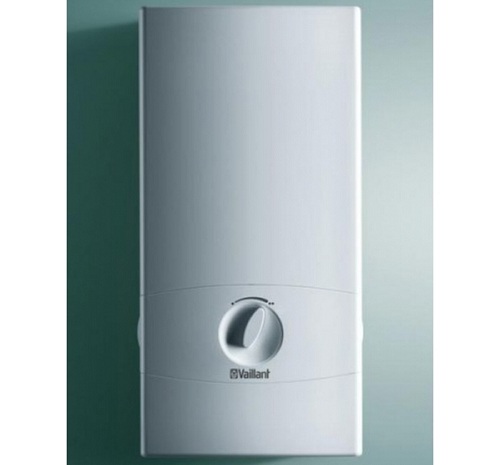
Water heater VAILLANT VED 24 H / 7
Storage boilers
- AEG EWH 80 Comfort EL. The model of the German concern has electric heating element. Capacity for water is 80 liters. The device operates at a low power of 1.8 kW. The digital display contains information about the set value of the set temperature and the included programs. The tank is protected against corrosion due to the enamel coating and the installed magnesium protective anode. The device operates in three modes. The cost of 36,100 rubles.
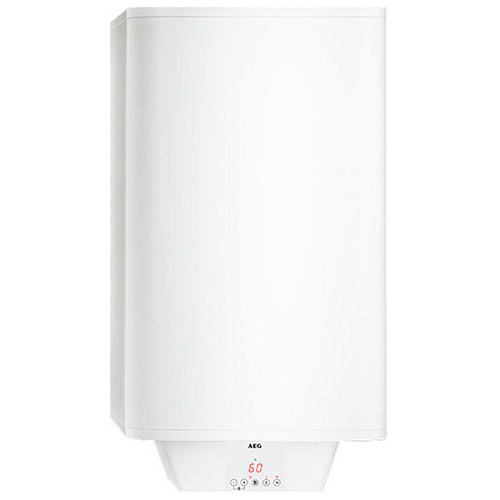
Water heater AEG EWH 80 Comfort EL
- Ariston SGA 150. The case is made of high-strength steel, the inner wall of the tank is made of waterproof enamel coating. Gas heating element. Capacity for water is 155 liters. Additional features of the device include the presence of sensors temperature limit and smoke removal. Equipment power 7,22 kW. The mass of the device is about 53 kg. The cost of 29,800 rubles.

Water heater Ariston SGA 150
Choosing between running and storage water heaters, buyers pay attention to the different opinions of people. About these devices speak so.
Evgeny, 34 years old, Moscow
Anna, 47 years old, Rostov-on-Don
Summarizing, we can say that the storage heater is suitable in those cases if hot water is required regularly and at full power. Devices can have 2 heating elements with the function of accelerated heating of the liquid. For a private building or a country house is definitely preferable instantaneous water heater.

/rating_off.png)












